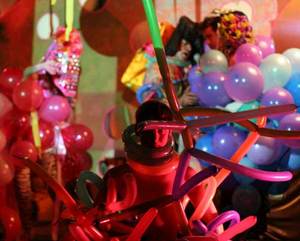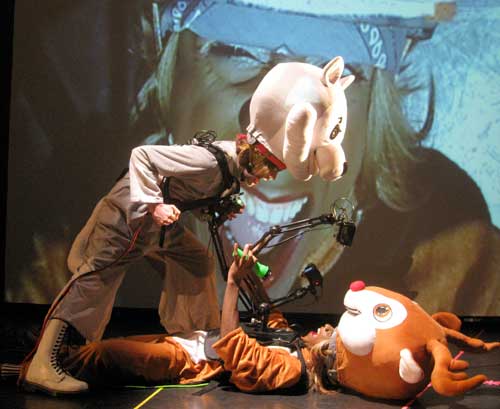This is an archive of the ArtCat Zine, 2007-2009. Please visit our new project, IDIOM.
Alienation Perfected: Big Art Group at the Kitchen
The problem of critiquing the critical lingers large in the realm of performance. This is due, I suspect, to the fact that unlike any other serious medium, there remains a powerful industry devoted to psychological realism – the well-made play and the like. It's an industry that, in short, still orients itself by a 19th century standard of beauty. Jokes about painting non-withstanding, this is not the case in the art world, which is now several generations removed from the introduction of the abstract, the conceptual, and the critical into the edifice of its reception. Most patrons of performance and many of its producers, by contrast, are often, and at best, only dimly aware of some other history lurking in the margins. This obvious tragedy has many causes, and many more symptoms, one of the most pernicious being the general lack of a common vocabulary amongst critics, producers, and artists. It is no surprise, to put it another way, that so much of contemporary artistic practice relies quite heavily on an apparatus of orientation existing outside the work itself: the press release, the brochure, the critical assessment. Over time these many bits of explanation collect and calcify into a thriving community capable of digesting, even demanding, an ever-evolving, relentless assault on the status quo.
Thus the difficulty in sorting out ‘SOS,’ Caden Manson/Big Art Group’s demolition derby of an evening that opened last Thursday at The Kitchen. If it were playplay, like so many others throughout the island, it would be easy enough to assert what works and what doesn’t, but Manson, to his great credit, has never been satisfied with anything so simple. The result is that any perceived deficiency – like, say, the fact that what promises to be a very interesting script is only regularly discernible when spoken by one of the five performers – could easily be interpreted as entirely the point. Perhaps Big Art is interested in generating our frustration at not being able to understand what is being said most of the time. This, in turn, could be read as a critique of a world that is estranged from most people, most of the time. However, I doubt it. Instead I think that Big Art, as artists and as a crew, are fundamentally oriented towards the visual, and as their visuals have gotten more and more interesting and complex, they have let their sound design go to shit. The result is that sound layers that should, if the care taken with the visual is any indication, have separate speakers, subwoofers, outputs, and the like, are all mixed down and forced through pathetically overmatched channels. This is an example of form defeating content, (as is, it must be said, the inability of most of the performers to stay on-voice) as the actual sounds involved are quite precise and appropriate, even delightful, it's just clear that Big Art has yet to isolate the aural equivalent of their groundbreaking Real Time Film technique.

And that technique remains powerful, to be sure. Real Time Film is the use of several video cameras, and several more screens, to layer live actors, backgrounds into a comical facsimile of spectacular image production. Big Art literally stages the vampiric synthesis of modern media, pulling it apart piece by piece. This work is advanced by the choice, evident in SOS, to chain certain segments of the narrative to certain visual arrangements, or dare we say modes of production. Thus the insane back and forth of two social networking addicts – easily the best segments in the piece – are actually limited to a single green screen per performer, reflecting on the isolation implied by these new technologies. The genre-shifting adventures of several quasi-revolutionary transsexual TV-stars, by contrast, get the full Real Time treatment, at one point layering themselves into multiple cardboard dashboards for a sensationally realized car chase. It was in these segments where I would really have liked to have understood better what the characters were saying, if only because the myriad genres were all rendered at more or less the same breakneck pace. Whether you want to interpret that sentiment, voiced in this context, as a meta-presentational extension of the radioactive half-life of such a performance, capable of being detached and applied to all of para-modern synthetic existence, or as the reactionary grumblings of a budding neo-conservative on the wrong side of 25, is up to you.
Regardless though, I think anyone would agree that the third of the three repeating cycles, involving several animals lost in the woods, is the least compelling of what’s on offer here. Intended, one suspects, to be a somewhat lighthearted interrogation of identity politics, the visual choice, which has video camera’s focused on the performer’s faces mounted directly in front of them, quickly becomes uninteresting. And the oversize animal suits seem to bring out the worst in the performers, who see it as an opportunity as a chance to shriek into their microphones, and not in a good way.
All that aside, the final moment, my companion and I agreed, was the single most visually compelling thing we have seen on stage, maybe ever, and likely worth the price of admission in and of itself. To that end, it also served as a reminder that Big Art Group remains one of the boldest crews around, and their work at the intersection of video and performance persists as uniquely important. One hopes that in their next incarnation, that same level of care and investment will be extended to all aspects of the performance, even those suffering only in contrast to their mastery of the almighty spectacle.
ZINE
HOME
TIPS / COMMENTS
CATEGORIES
CONTRIBUTORS
- Greg Afinogenov
- B. Blagojevic
- Adda Birnir
- Susannah Edelbaum
- Julie Fishkin
- Paddy Johnson
- Jessica Loudis
- Christopher Reiger
- Andrew Robinson
- Peter J. Russo
- Blythe Sheldon
- S.C.Squibb
- Hrag Vartanian

